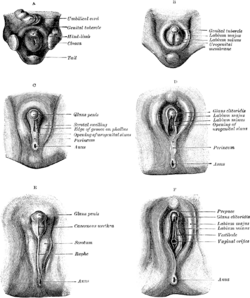Genital tubercle: Difference between revisions
Tom.Reding (talk | contribs) m →External links: Rem stub tag(s) (class = non-stub & non-list) using AWB |
Rescuing 1 sources and tagging 0 as dead. #IABot (v1.5.7) |
||
| Line 30: | Line 30: | ||
==External links== |
==External links== |
||
* {{EmbryologySwiss|ugenital/genitexterne01}} |
* {{EmbryologySwiss|ugenital/genitexterne01}} |
||
* [http://sprojects.mmi.mcgill.ca/embryology/ug/Reproductives/Normal/Male_external.html Overview at mcgill.ca] |
* [https://web.archive.org/web/20060429053315/http://sprojects.mmi.mcgill.ca/embryology/ug/Reproductives/Normal/Male_external.html Overview at mcgill.ca] |
||
{{Development of urinary and reproductive systems}} |
{{Development of urinary and reproductive systems}} |
||
Revision as of 20:25, 12 October 2017
| Genital tubercle | |
|---|---|
 Stages in the development of the external sexual organs in the male and female. | |
| Details | |
| Precursor | somatopleure[1] |
| Gives rise to | genital swelling, mons pubis, clitoris, penis |
| Identifiers | |
| Latin | tuberculum phallicum; tuberculum genitale |
| TE | tubercle_by_E5.7.4.0.1.0.1 E5.7.4.0.1.0.1 |
| Anatomical terminology | |
A genital tubercle or phallic tubercle is a body of tissue present in the development of the reproductive system. It forms in the ventral, caudal region of mammalian embryos of both sexes, and eventually develops into a primordial phallus. In the human fetus, the genital tubercle develops around week 4 of gestation, and by week 9 becomes recognizably either a clitoris or penis. This should not be confused with the sinus tubercle which is a proliferation of endoderm induced by paramesonephric ducts. Even after the phallus is developed, the term genital tubercle remains, but only as the terminal end of it,[2] which develops into either the glans penis or the glans clitoridis.
The genital tubercle is sensitive to dihydrotestosterone and rich in 5-alpha-reductase, so that the amount of fetal testosterone present after the second month is a major determinant of phallus size at birth.
See also
References
- ^ Netter, Frank H.; Cochard, Larry R. (2002). Netter's Atlas of human embryology. Teterboro, N.J: Icon Learning Systems. p. 159. ISBN 0-914168-99-1.
- ^ The University of North Carolina at Chapel Hill - Embryo images nr 024
External links
- Swiss embryology (from UL, UB, and UF) ugenital/genitexterne01
- Overview at mcgill.ca
